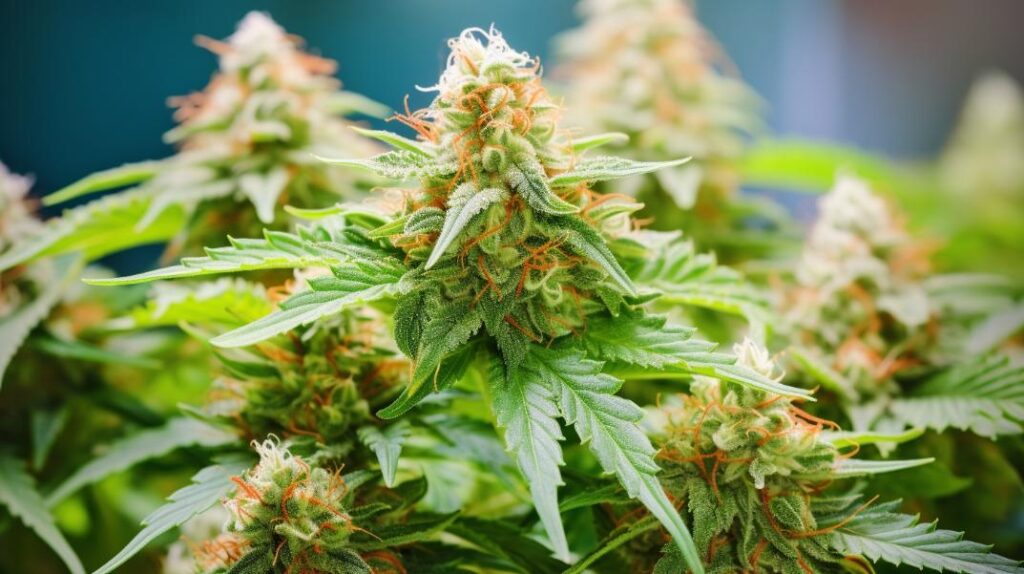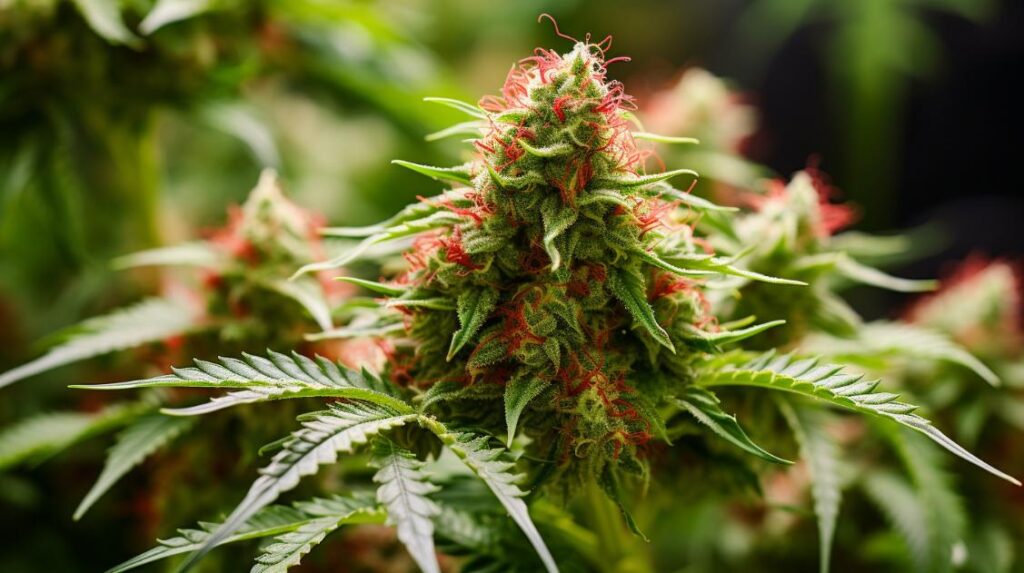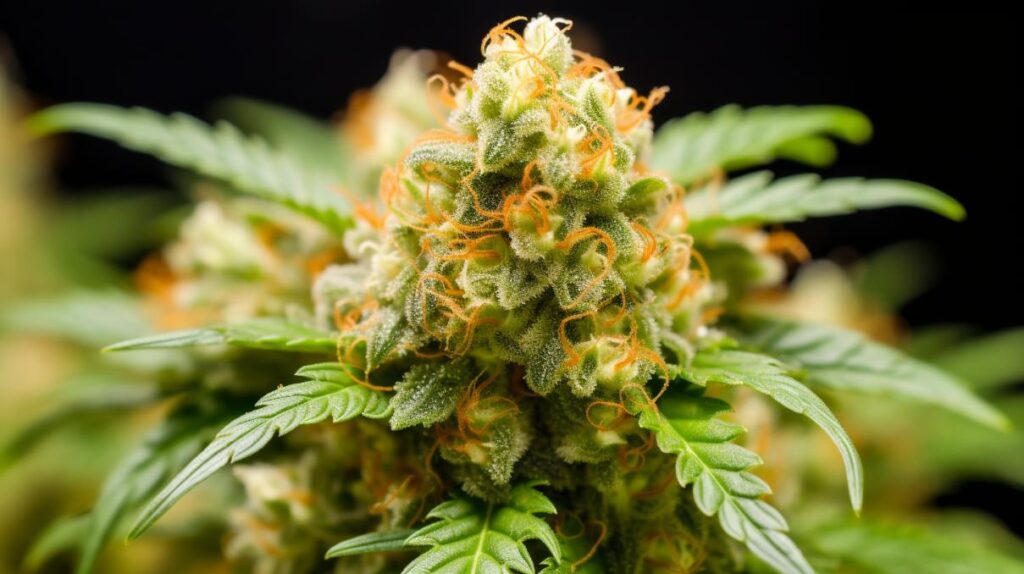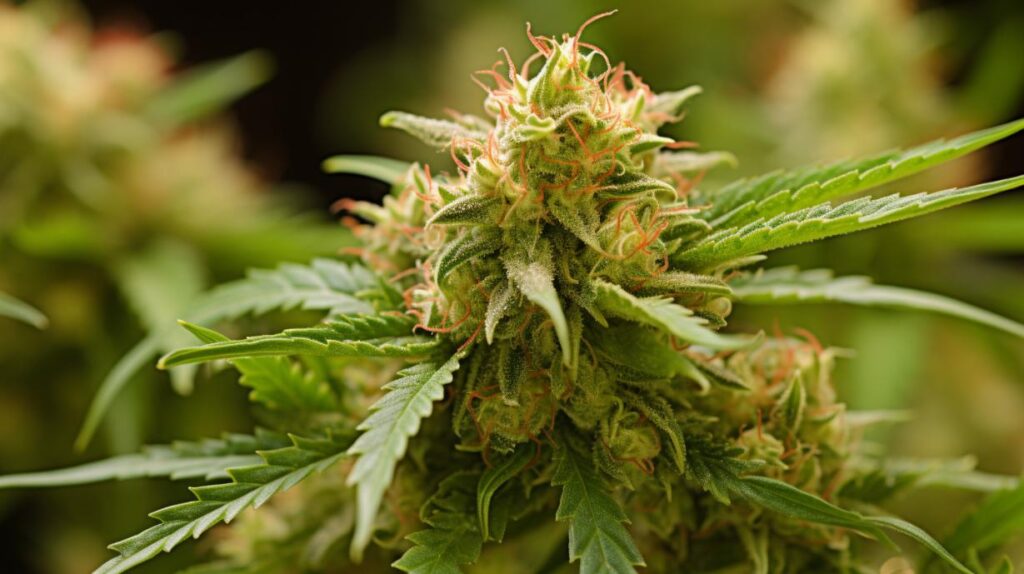Starburst (aka Starburst OG, Starburst Kush)

The Starburst Strain, a hybrid marvel born from the intricate crossing of Pre-98 Bubba Kush and Fire OG, represents a fascinating convergence of genetics that offer both medicinal and recreational appeal.
With its distinct peppery flavor profile and the promise of an upbeat, energetic high, this strain has garnered attention for its potential in managing conditions such as chronic stress, anxiety, and pain.
However, beneath its surface lies a complex terpene profile and a rich history that traces back to its origins. As we explore the nuances of its genetic lineage and the implications for users and growers alike, one must consider the broader impacts of such strains on the evolving cannabis landscape.
Genetic Lineage
The genetic lineage of the Starburst strain, a dynamic hybrid resulting from the crossbreeding of Pre-98 Bubba Kush and Fire OG, plays a pivotal role in shaping its distinctive flavor profile and therapeutic effects. This lineage is a testament to the careful selection and breeding practices within the cannabis community, aimed at combining the best traits of these well-regarded parent strains.
Pre-98 Bubba Kush, known for its relaxing and sedative properties, contributes to Starburst’s potential for stress relief and easing of physical discomfort. Conversely, Fire OG, characterized by its potent effects and complex citrus, pine, and woody flavors, imbues Starburst with a vibrant and engaging sensory experience.
Understanding the genetic lineage of Starburst is crucial for both cultivators and consumers. For cultivators, it informs breeding practices and cultivation techniques to enhance desired traits. For consumers, it provides insight into the strain’s potential effects, guiding their selection process. The genetic makeup of Starburst, derived from its distinguished predecessors, thus significantly influences its overall qualities and attributes, offering a unique combination of therapeutic benefits and sensory pleasures within the cannabis spectrum.
History and Origin
Understanding the genetic lineage of the Starburst strain provides a solid foundation for exploring its history and origin, highlighting how this hybrid emerged as a noteworthy addition to the cannabis market. The creation of Starburst, a hybrid resulting from the crossbreeding of Pre-98 Bubba Kush and Fire OG, represents a significant development in the pursuit of strains that balance recreational appeal with therapeutic potential. This particular combination was selected with the aim of producing a strain that offers an upbeat and buzzy high, complemented by a complex flavor profile characterized by peppery notes with undertones of strawberry, peach, and orange.
The Starburst strain, also known in the cannabis community as Starburst OG or Starburst Kush, has gained popularity for its versatility in addressing both recreational and medicinal needs. Its efficacy in providing pain relief, reducing anxiety, and inducing feelings of happiness and relaxation underlines the strain’s value in the realm of cannabis for medical purposes. The development and cultivation of Starburst are indicative of the evolving landscape of cannabis cultivation, where the goal is to achieve a balance between enhancing the user’s experience and meeting professional healthcare needs.
THC/CBD Content
Regarding the THC/CBD content of the Starburst strain, it showcases a THC concentration ranging between 26% and 33%, positioning it as a potent option for seasoned cannabis consumers. The CBD content, on the other hand, is notably low, typically below 1%. This composition emphasizes the strain’s psychoactive potential rather than its non-psychoactive, therapeutic benefits.
Given its robust THC profile, Starburst strain is particularly significant in contexts where a strong psychoactive effect is desired or beneficial. However, the low CBD percentage suggests that users looking primarily for the medical benefits associated with CBD might need to consider alternative strains or supplementary CBD products. It’s important to approach the use of Starburst strain with a clear understanding of its potent nature and to adjust dosing according to individual tolerance and experience.
- The high THC content signifies strong psychoactive effects, making it suitable for experienced users.
- CBD content under 1% focuses the experience on psychoactivity rather than CBD’s therapeutic benefits.
- Cannabinoids like THCa, CBDa, CBG, and CBN contribute to its complex effects.
- The presence of CBG and CBN may offer subtle medical benefits despite the low CBD.
- Dosing recommendations highlight the importance of moderation and individualized consumption strategies.
Professional advice should be sought to navigate its use responsibly, especially in a medical context.
Terpene Profile
Delving into the terpene profile of the Starburst strain reveals a complex array of compounds, including Beta Myrcene, Limonene, Linalool, Beta Caryophyllene, Humulene, Beta Pinene, and Alpha Pinene, each contributing to its distinctive aroma, flavor, and potential therapeutic effects. These terpenes are essential not only for their sensory impact but for their synergistic role in enhancing the strain’s overall efficacy.
The terpene profile of Starburst is rich and varied, providing a unique sensory experience. Beta Myrcene, the most prevalent terpene, is known for its earthy, musky notes, and is believed to contribute to the relaxing effects associated with this strain. Limonene and Linalool add a sweet, citrusy layer, complemented by the potential anti-anxiety and calming properties they are reputed for. On the other hand, Beta Caryophyllene and Humulene introduce a spicy, woody essence, with Caryophyllene also offering anti-inflammatory benefits and Humulene contributing to appetite suppression.
| Terpene | Key Attributes |
|---|---|
| Beta Myrcene | Earthy, musky, relaxing effects |
| Limonene | Citrusy, sweet, anti-anxiety |
| Linalool | Floral, calming |
| Beta Caryophyllene | Spicy, woody, anti-inflammatory |
| Humulene | Earthy, woody, appetite suppression |
Understanding the terpene profile of the Starburst strain is crucial for users seeking specific experiences or therapeutic benefits, highlighting the importance of terpenes in cannabis strains.
Effects
The Starburst strain is renowned for its potent effects, which include inducing a state of euphoria, enhancing sensory perception, and fostering a sense of focused energy. With a high THC level ranging between 26% and 33%, this strain delivers long-lasting outcomes that many people find beneficial for various conditions. Unlike strains with similar effects, Starburst has a unique combination of inducing clarity and relaxation while also promoting a vibrant and euphoric high, making it particularly appealing to experienced users.
- Euphoric High: Users often report a significant elevation in mood, leading to feelings of happiness and euphoria.
- Enhanced Sensory Perception: Starburst strain is known to intensify senses, making colors seem brighter and sounds more distinct.
- Focused Energy: It fosters a state of alertness and energy, allowing users to remain productive.
- Physical Relaxation: Despite its energizing effects, Starburst also offers relaxation, helping to alleviate physical tension.
- Giggly and Energetic: A common effect is a sense of giddiness, making social interactions more enjoyable.
Professionals and experienced patients dealing with chronic stress, anxiety, and other similar conditions often seek out Starburst for its multifaceted effects.
Medical Uses
Often, individuals turn to the Starburst strain for its potential therapeutic applications, particularly in the realms of anxiety relief, pain management, and insomnia mitigation. The strain’s efficacy in these areas is underscored by user-reported outcomes, highlighting its role in the broader context of health and well-being. While these benefits are derived from anecdotal evidence rather than professional medical advice, they offer a glimpse into the potential utility of the Starburst strain in addressing certain health concerns.
| Benefit | Percentage of Users Reporting Positive Effects |
|---|---|
| Anxiety Relief | 29% |
| Pain Relief | 23% |
| Insomnia Relief | 17% |
| Overall Satisfaction | Based on individual feedback |
This data-driven approach provides a foundation for understanding the practical applications of the Starburst strain in the management of specific health issues. It’s important to note, however, that these figures represent user experiences and should not be taken as a substitute for professional medical advice. The therapeutic potential of the Starburst strain, while promising, underscores the necessity for further research and clinical trials to validate these anecdotal claims.
Flavor and Aroma
Many users report that the Starburst strain delivers a unique combination of sweet and sour lemon candy flavors, complemented by distinctive notes of diesel and pine aromas. This complex interplay between flavor and aroma creates a memorable experience for real people who seek both novelty and depth in their cannabis selections. The profile of Starburst strain is marked by a meticulously balanced blend that appeals to a broad spectrum of palates, reflecting the sophistication of its breeding.
-
Sweet and Sour Lemon Candy Taste: The primary flavor is a vibrant mix of sweet and sour, reminiscent of lemon candy, which provides an initial burst of freshness.
-
Diesel and Pine Aromas: These earthy and woody undertones add a rich layer of complexity, grounding the sweetness with a savory finish.
-
Fruity Notes of Strawberry, Peach, and Orange: This trio introduces a refreshing and juicy element, enhancing the overall sensory experience.
-
Gassy Undertone: A subtle yet distinct gassy taste intertwines with the sweet flavors, adding depth and an unexpected twist.
-
Refreshing and Enjoyable Experience: The combination of these elements makes Starburst strain notably refreshing and enjoyable, offering a unique taste and aroma landscape.
This detailed, analytical exploration reveals how the Starburst strain’s flavor and aroma profiles are crafted to engage and satisfy the discerning preferences of real people.
Appearance
Building on the intricate flavor and aroma profile, the Starburst strain further impresses with its visually striking appearance, characterized by dense, compact buds and vibrant hues. Cultivators and enthusiasts alike marvel at the Starburst strain, often referred to as Starburst OG, for its remarkable visual characteristics that signify its quality and potency. The buds of this strain are not only dense and compact but also rich in vibrant green colors complemented by orange pistils that stand out against the foliage. Moreover, the presence of frost-like trichomes suggests a high resin production, a trait highly sought after for its implications on potency and flavor.
The appearance of Starburst OG is further enhanced when the cultivation conditions coax out the purple undertones, adding an exotic flair to its visual appeal. This coloration, coupled with a mix of light and dark green leaves, creates a contrast that is both eye-catching and indicative of a well-cared-for plant.
| Characteristic | Description | Implication |
|---|---|---|
| Bud Density | Dense and compact | High-quality and potent |
| Color | Vibrant green with purple undertones | Visual appeal and potency |
| Trichomes | Frosty appearance | High resin production |
| Leaves | Mix of light and dark green | Healthy, vigorous growth |
This detailed examination reveals that the Starburst strain is a visually appealing cannabis variety, with each characteristic hinting at the underlying quality and care taken in its cultivation.
Grow Information
Delving into the cultivation specifics, the Starburst strain emerges as a balanced hybrid, boasting an equal genetic split between indica and sativa influences. This equilibrium in its genetic makeup provides a unique cultivation experience, characterized by its moderate flowering time and adaptability to different growing environments. Originating from a cross between Lemon Larry and Nebula genetics, Starburst carries with it the robust lineage of Pre-98 Bubba Kush and Fire OG, two strains renowned for their potent effects and complex flavors.
- Flowering Time: Indoors, the Starburst strain completes its flowering cycle in approximately 56 days, aligning with an 8-week cultivation period for optimal yield and potency.
- Genetic Lineage: A hybridization of Lemon Larry and Nebula, enriched by the formidable genetics of Pre-98 Bubba Kush and Fire OG.
- Indica/Sativa Composition: A 50/50 blend offers a balanced growth pattern, making it suitable for both indoor and outdoor cultivation practices.
- Harvest Period: For outdoor growers, the harvest time should be carefully planned to coincide with the optimal environmental conditions, leveraging its adaptability to enhance yield.
- Cultivation Difficulty: Moderate, requiring attention to detail in environmental control and nutrient management to fully express its genetic potential.
This analytical overview encapsulates the Starburst strain’s grow information, highlighting its balanced genetic composition and the influence of its notable lineage.
Adverse Effects
After exploring the cultivation details of the Starburst strain, it is equally important to address its potential adverse effects, notably dry eyes and dry mouth, which are common among many cannabis varieties. These side effects, while not severe, can cause discomfort and detract from the overall experience of using the Starburst strain.
Specifically, dry eyes may lead to irritation, redness, and a sensation of grittiness, potentially exacerbating conditions like conjunctivitis if not addressed promptly. On the other hand, dry mouth can cause a parched feeling, leading to increased thirst and a sticky or uncomfortable sensation in the oral cavity.
To mitigate these adverse effects, it is advisable for users to prepare by having hydrating solutions readily available. For instance, the application of artificial tears or lubricating eye drops can provide immediate relief for dry eyes, restoring moisture and alleviating irritation. Similarly, maintaining adequate hydration by drinking water before, during, and after consumption of the Starburst strain can significantly reduce the impact of dry mouth.
These preventative measures not only enhance the user experience but also underscore the importance of responsible consumption practices when engaging with cannabis products like the Starburst strain.
Comparisons with Similar Strains
When comparing the Starburst strain to its counterparts like Purple Starburst and StarBurst Bubba, it is essential to consider the nuances in their genetic makeup, flavor profiles, and psychoactive effects to understand the distinct user experiences they offer. The Starburst strain, a hybrid of Pre-98 Bubba Kush and Fire OG, is particularly noted for its vibrant, euphoric high and unique taste. Its high THC levels, ranging from 26% to 33%, make it a choice for those seeking intense effects.
- Genetic Background: Starburst Kush derives from a blend of Pre-98 Bubba Kush and Fire OG, offering a complex genetic profile compared to Purple Starburst and StarBurst Bubba.
- Flavor Profile: The peppery base with notes of strawberry, peach, and orange sets it apart from its relatives, who may offer variations in taste.
- THC Content: With THC levels hitting the 26%-33% range, Starburst is on the higher end of potency.
- Effects on Users: Reports of feeling giggly, energetic, and focused highlight the unique psychoactive experiences.
- Usage Considerations: Given its potency, users should seek the advice of experienced peers or professionals before trying Starburst Kush, especially those new to cannabis or with lower tolerance levels.
Research and Studies
Exploring the Starburst strain reveals a landscape marked by a scarcity of formal research studies, reflecting the broader challenges within cannabis research. The evolving nature of cannabis research has resulted in limited formal investigations specifically targeting the Starburst strain. This gap underscores a critical need for scientific rigor and methodical exploration to unravel the full spectrum of its properties and potential medical applications. Key insights are often sourced from user feedback and anecdotal reports, which, while valuable, underscore the variability of individual experiences. These subjective accounts emphasize the importance of acknowledging personal tolerance and preferences when considering the Starburst strain.
The lack of extensive clinical trials specifically concerning the Starburst strain illuminates a broader issue within the field of cannabis research. It highlights an urgent need for more structured scientific studies to validate anecdotal evidence and explore potential therapeutic benefits in a controlled, empirical manner. Prospective users are advised to consult a health professional before using the Starburst strain, ensuring an informed approach that considers both the potential benefits and the current limitations of available research. As interest in cannabis research continues to grow, it is anticipated that more comprehensive studies will emerge, offering clearer insights into strains like Starburst and their place within therapeutic contexts.
Frequently Asked Questions
Is Starburst a Sativa or Indica?
Starburst, characterized by its genetics comprising Lemon Larry and Nebula, is a predominantly sativa hybrid. Its cultivation techniques emphasize a flowering time of approximately 56 days, highlighting its sativa-dominant effects and rapid growth cycle.
Is Pink Starburst Strain Strong?
The Pink Starburst strain is notably potent, with THC levels reaching up to 24%. Its robust effects are complemented by a sweet, fruity flavor profile. Optimal growing conditions are crucial for maximizing its potency and flavor nuances.
What Is the Most Potent Sativa Strain Ever?
The most potent Sativa strain ever, Ghost Train Haze, addresses Sativa cultivation challenges with its high THC levels (25%-27%) and showcases Sativa medical benefits such as enhanced creativity and energy, making it highly sought after.
What Is the Most Intense High Strain?
The most intense high strain often involves a detailed THC content comparison and genetic heritage exploration. Strains with high THC levels, typically over 25%, exhibit powerful psychoactive effects, catering to experienced users seeking profound euphoria and relaxation.







Responses